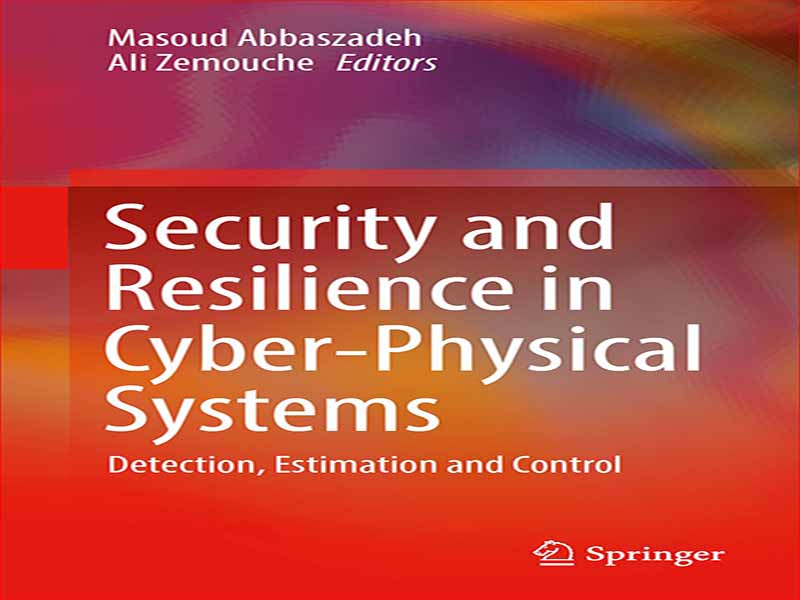- عنوان کتاب: Security and Resilience of Cyber-Physical Systems
- نویسنده/انتشارات: Masoud Abbaszadeh, Ali Zemouche
- حوزه: سیستم فیزیکی سایبری
- سال انتشار: 2022
- تعداد صفحه: 383
- زبان اصلی: انگلیسی
- نوع فایل: pdf
- حجم فایل: 10.60 مگابایت
سیستمهای فیزیکی-سایبری قابلیت همکاری دنیای سایبری و فیزیکی را از طریق کنترل، محاسبات و ارتباطات امکانپذیر میسازند. طرحهای کنترل، بهینهسازی، نظارت و تشخیصی که سیستمهای فیزیکی-سایبری را اجرا میکنند (مانند تولید برق، حملونقل، نفت و گاز، سیستمهای محاسباتی و ارتباطی، سیستمهای مراقبتهای بهداشتی و غیره) به طور فزایندهای از طریق شبکههای محلی یا اینترنت متصل میشوند. در نتیجه، این سیستمهای کنترلی به طور فزایندهای در برابر تهدیدات و پارازیتهایی مانند حملات سایبری (مثلاً مرتبط با ویروس رایانهای، نرمافزار مخرب و غیره) آسیبپذیر شدهاند که میتواند عملکرد آنها را مختل کند، به تجهیزات آسیب برساند، عملکرد نادرست ایجاد کند و غیره. بسیاری از روشهای کنونی امنیت سایبری عمدتاً تشخیص و کاهش حملات را در فناوری اطلاعات (“IT”، مانند رایانههایی که دادهها را ذخیره، بازیابی، انتقال، دستکاری میکنند) و فناوری عملیاتی (“OT”، مانند دستگاههای نظارت مستقیم و رابطهای اتوبوس ارتباطی در نظر میگیرند. ) در شبکه و لایه های ارتباطی. حملات سایبری همچنان می توانند از طریق این لایه های حفاظتی نفوذ کنند و به «دامنه» فیزیکی برسند، همانطور که در سال 2010 با حمله استاکس نت مشاهده شد. چنین حملاتی می تواند بر عملکرد یک سیستم کنترل تأثیر منفی بگذارد و ممکن است باعث خاموش شدن کامل یا آسیب فاجعه بار به سیستم شود. در حال حاضر، روشهای کمتری برای شناسایی خودکار حملات در طول یک حادثه سایبری در لایه حوزه فیزیکی (یعنی سطح فرآیند) که در آن حسگرها، کنترلکنندهها و محرکها قرار دارند، در دسترس است. در برخی موارد، چندین حمله ممکن است به طور همزمان رخ دهد (به عنوان مثال، ممکن است همزمان بیش از یک محرک، سنسور یا پارامتر در داخل دستگاه های سیستم کنترل به طور مخرب توسط یک شخص غیرمجاز تغییر داده شود). علاوه بر این، برخی از پیامدهای ظریف حملات سایبری، مانند حملات پنهانی که در لایه فیزیکی رخ میدهند، ممکن است به آسانی قابل تشخیص نباشند (به عنوان مثال، زمانی که تنها یک گره نظارتی، مانند یک گره حسگر، در یک الگوریتم تشخیص استفاده میشود).
Cyber-physical systems enable interoperability of cyber and physical worlds through control, computation, and communications. Control, optimization, monitoring, and diagnostic schemes that operate cyber-physical systems (e.g., power generation, transportation, oil & gas, computing and communication systems, healthcare systems, etc.) are increasingly connected via local networks or the Internet. As a result, these control systems have been increasingly vulnerable to threats and jamming, such as cyber-attacks (e.g., associated with a computer virus, malicious software, etc.), that could disrupt their operation, damage equipment, inflict malfunctions, etc. Many of current cybersecurity methods primarily consider attack detection and mitigation in Information Technology (“IT”, such as, computers that store, retrieve, transmit, manipulate data) and OperationalTechnology (“OT”, such as direct monitoring devices and communication bus interfaces) at the network and communication layers. Cyber-attacks can still penetrate through these protection layers and reach the physical “domain” as seen in 2010 with the Stuxnet attack. Such attacks can negatively affect the performance of a control system and may cause total shut down or catastrophic damage to the system. Currently, fewer methods are available to automatically detect, during a cyber-incident, attacks at the physical domain layer (i.e. the process level) where sensors, controllers, and actuators are located. In some cases,multiple attacks may occur simultaneously (e.g., more than one actuator, sensor, or parameter inside control system devices might be altered maliciously by an unauthorized party at the same time). Furthermore, some subtle consequences of cyber-attacks, such as stealthy attacks occurring at the physical layer, might not be readily detectable (e.g.,when only one monitoring node, such as a sensor node, is used in a detection algorithm).
این کتاب را میتوانید از لینک زیر بصورت رایگان دانلود کنید:



































نظرات کاربران